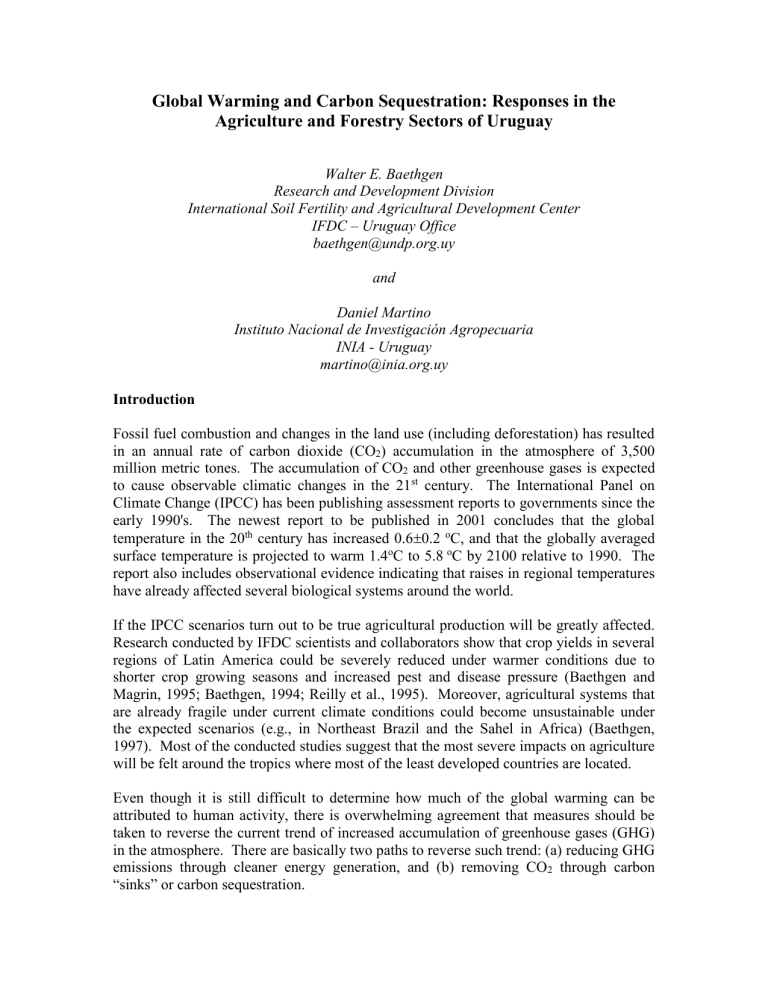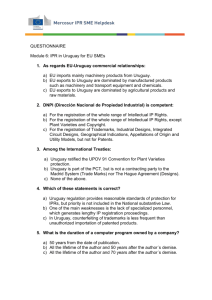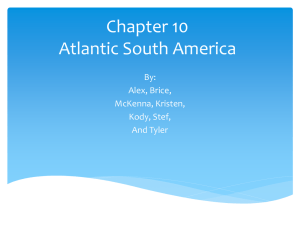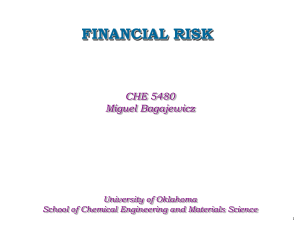Dear Marie: - Socioeconomic Data and Applications Center

Global Warming and Carbon Sequestration: Responses in the
Agriculture and Forestry Sectors of Uruguay
Walter E. Baethgen
Research and Development Division
International Soil Fertility and Agricultural Development Center
IFDC – Uruguay Office baethgen@undp.org.uy and
Daniel Martino
Instituto Nacional de Investigación Agropecuaria
INIA - Uruguay martino@inia.org.uy
Introduction
Fossil fuel combustion and changes in the land use (including deforestation) has resulted in an annual rate of carbon dioxide (CO
2
) accumulation in the atmosphere of 3,500 million metric tones. The accumulation of CO
2
and other greenhouse gases is expected to cause observable climatic changes in the 21 st
century. The International Panel on
Climate Change (IPCC) has been publishing assessment reports to governments since the early 1990's. The newest report to be published in 2001 concludes that the global temperature in the 20 th
century has increased 0.6
0.2 o
C, and that the globally averaged surface temperature is projected to warm 1.4
o C to 5.8
o C by 2100 relative to 1990. The report also includes observational evidence indicating that raises in regional temperatures have already affected several biological systems around the world.
If the IPCC scenarios turn out to be true agricultural production will be greatly affected.
Research conducted by IFDC scientists and collaborators show that crop yields in several regions of Latin America could be severely reduced under warmer conditions due to shorter crop growing seasons and increased pest and disease pressure (Baethgen and
Magrin, 1995; Baethgen, 1994; Reilly et al., 1995). Moreover, agricultural systems that are already fragile under current climate conditions could become unsustainable under the expected scenarios (e.g., in Northeast Brazil and the Sahel in Africa) (Baethgen,
1997). Most of the conducted studies suggest that the most severe impacts on agriculture will be felt around the tropics where most of the least developed countries are located.
Even though it is still difficult to determine how much of the global warming can be attributed to human activity, there is overwhelming agreement that measures should be taken to reverse the current trend of increased accumulation of greenhouse gases (GHG) in the atmosphere. There are basically two paths to reverse such trend: (a) reducing GHG emissions through cleaner energy generation, and (b) removing CO
2
through carbon
“sinks” or carbon sequestration.
Regarding the option of removing CO
2
from the atmosphere, IPCC has estimated that agricultural lands have the potential for removing 40,000 - 80,000 million metric tones of carbon over the next 50 to 100 years. Thus, soil carbon sequestration in agricultural lands alone might offset the effects of fossil fuel emissions and land use changes for 10-
20 years or longer. Additional carbon can be sequestered in well-managed forests and grassland soils.
There is thus a clear role for the agricultural sector to help reduce the enhanced greenhouse effect by introducing agronomic practices that result in increased removal of carbon dioxide from the atmosphere. Carbon dioxide is one of the most important gases that enhance the greenhouse effect. It is produced when coal, oil, wood, and other carbon-based fuels are burned. Plants absorb carbon dioxide and through photosynthesis convert it into dry matter (food, fiber, wood). Carbon fixed by plants can remain in the form of wood for several years, and /or return to the soil as plant residues increasing the soil organic matter content. The enhanced carbon sequestration strategy in the agricultural sector cannot be viewed as the permanent solution for the GHG emission problem, but it can be an excellent option for "buying time" and allow for the development and global adoption of new, clean and safe energy sources.
The Uruguay Case
Past and recent research has evidenced that reduction in atmospheric carbon dioxide content can be achieved by large-scale applications of land management practices. In order to succeed in the establishment of these better land management practices in the developing world, farmers must see economic advantages in the recommended practices.
When this is the case, a win/win situation is established: farmers obtain better income and the country improve the management of its natural resources.
Some examples of management practices that result in win/win situations in the agricultural sector include among others: establishment of forests and grasslands in former croplands and degraded soils, reduced tillage, use of pastures (e.g., clovers, alfalfa) in rotation with annual crops, improved strategies to enhance fertilizer use efficiency, increased efficiency of animal feed and return of animal waste. In addition to achieving higher and sustained farmer income, increasing sequestered carbon in the soils provides additional benefits to farmers such as improvement in soil fertility, water holding capacity and tilth, as well as reduction in soil erosion.
Experiences around the world show that financial incentives can dramatically affect the trends in agricultural production and affect greenhouse gas net emissions. A good example of this can be found in Uruguay, South America. The government of Uruguay started promoting the establishment of new forests with a “Forestry Law” passed in 1989 which included subsidies, tax cuts and other financial incentives to farmers who would plant new forests. As a result of that law, the area of new forests has increased almost 8fold in the last 10 years (Baethgen and Martino, 2000).
In order to take advantage of the benefits included in the Forestry law, farmers must plant new forests in soils which the law defined as “forestry priority”. These are soils that are currently under low-production natural grasslands. The amount of carbon produced annually in these grasslands varies between 2-4 ton C per ha. Under the Uruguayan conditions the tree species included in the Forestry Law (Eucalyptus, Pinus) show very high growth rates, and therefore, the newly planted trees in these same soils are now producing up to 8 ton C per ha per year.
The results of the last published National Inventory of Greenhouse Gases of Uruguay
(DINAMA, 1998) indicated that in 1994 the annual amount of CO
2
sequestered in the new forests compensated for the total annual emissions of this gas from the energy sector.
Recently published results of the 1998 National Greenhouse Gas Inventory and unpublished results of the 2000 National Inventory (Baethgen, unpublished) show that the total amount of carbon annually sequestered in new forests continued to increase
(Table 1). Under the scenario of a developed carbon market, the financial incentives that are now provided by the government through the Forestry Law could be substituted by the additional income resulting from trading carbon certificates (Martino, 2000).
In addition to the continuously increasing land area being afforested, changes of land uses in the agricultural sector of Uruguay during the last decades are also contributing to increase the amount of carbon sequestered in the soil. For example, due to the pressures that farmers have been confronting related to lower prices of their products, the area of improved pastures has drastically increased since the 1970’s (Figure 1). Livestock production (beef, milk and wool) has become much more efficient due to the increased area of improved pastures. At the same time, the inclusion of legumes and fertilizers in the new pastures are also resulting in higher amounts of carbon sequestered in the soils.
Moreover, the area sown with annual crops with conventional tillage has been reduced, and the area of annual crops under no-till has increased (Figure 1). Crop production systems based on no-till also result in reduced soil erosion losses and increased carbon sequestration. As a result of these management practices the agricultural sector of
Uruguay (livestock and annual crops) is showing annual carbon balances with significant levels of net carbon sequestration (Figure 2). The increase areas of improved pastures have an additional benefit on the greenhouse gas situation. Livestock in Uruguay is now receiving a higher quality diet and producing more beef, milk and wool. Consequently, the resulting emissions of methane per unit of product has decreased.
Recent estimations using IPCC methodology are showing that in 2000 the cumulative effects of changes in the agricultural and forestry sectors of Uruguay are resulting in carbon sequestration levels that are approximately 50% higher that the total emission of carbon from the combined energy and industrial processes sectors of Uruguay (Table 2).
Concluding Remarks
There is now a strong need for establishing precise carbon balances in Uruguay with scientifically robust methods combining analyses, remote sensing and simulation models.
However, these preliminary results indicate the important effects of establishing adequate agricultural practices and promoting favorable land uses on the net greenhouse gas emissions of a country.
The Uruguayan example also demonstrates the important role that governments can play identifying and promoting adequate practices and land uses which result in higher and more sustained income for farmers, and at the same time improved natural resource base.
References
Baethgen, W.E. 1994. Impacts of climate change on barley in Uruguay: yield changes and analysis of nitrogen management systems.
IN: C. Rosenzweig and A. Iglesias
(ed.) Implications of Climate Change for International Agriculture: Crop
Modeling Study. USEPA 230-B-94-003, Washington, D.C.
Baethgen, W.E. 1997. Vulnerability of the agricultural sector of Latin America to climate change. Climate Res. 9:1-7
Baethgen, W.E. and A. Morón. 2000. Carbon Sequestration in Agricultural Production
Systems of Uruguay: Observed Data and CENTURY Model Simulation Runs.
Anales de la V Reunión de la Red Latinoamericana de Agricultura
Conservacionista, Florianópolis, Brasil.
Baethgen, W.E. and D.L. Martino. 2000. Climate change, greenhouse gases and implication for the agricultural and forestry sectors of Uruguay.
In: Proceedings of the Workshop on the Kyoto Protocol. Department for the Environment.
Government of Uruguay. (In Spanish)
Baethgen, W.E. and D.L. Martino. 2000. Greenhouse gas emissions from the agricultural and forestry sectors of Uruguay and opportunities in the carbon market. (In
Spanish) In: Proceedings of the Latin American Animal Science Society
Congress. Montevideo, Uruguay.
Baethgen, W.E. and G.O. Magrin. 1995. Assessing the impacts of climate change on winter crop production in Uruguay and Argentina using crop simulation models.
IN : C. Rosenzweig et al. (eds.), Climate Change and Agriculture: Analysis of
Potential International Impacts. American Society of Agronomy Special
Publication 59, Madison WI, pp. 207-228.
Dirección Nacional de Medio Ambiente (DINAMA). 1998. Inventario Nacional de
Emisiones Netas de Gases de Efecto Invernadero: 1994. 363pp. Minsiterio de
Vivienda, Ordenamiento Territorial y Medio Ambiente. Montevideo, Uruguay.
Martino, D.L. 2000. Carbon sinks in the Clean Development Mechanism of the Kyoto
Protocol. In: Proceedings of the Workshop on the Kyoto Protocol. Department for the Environment. Government of Uruguay. (In Spanish)
Reilly, J., W.E. Baethgen, F.E. Chege, S.C. van de Geijn, Lin Erda, A. Iglesias, G.Kenny,
D.Patterson, J. Rogasik, R. Ritter, C. Rosenzweig, W. Sombroek and J.
Westbrook. 1996. Agriculture in a changing climate: impacts and adaptation, IN:
Changing Climate: Impacts and Response Strategies, Report of Working Group II of the Intergovernmental Panel on Climate Change (IPCC). Cambridge University
Press.
Table 1: C and CO
2
Balance in the Forestry Sector 1990, 1994, 1998 and 2000
Absorption (+)/ Absorption (+)/
Annual Loss (-) Loss (-)
C Loss (net annual) (net annual)
(kTon C) (kTon C) (kTon CO
2
)
1990 1,073 -538 -1,972
1994
1998
1,083
967
236
1,076
865
3,945
Source:
2000 1,331 1,737
1990, 1994 and 1998 (DINAMA National Greenhouse Gas Inventories)
2000: Baethgen (unpublished, preliminary estimates).
6,369
Figure 1
13.5
13.0
Uruguay: Land Use Changes in Three Periods
(Area in million ha)
12.5
12.0
11.5
1.0
0.5
NG+Seed+Fert
AnPast
SwnPast (G+L)
NatGrass
AnCrp-CvT
AnCrp-NoT
0.0
1970 1975 1980 1985 1990 1995 2000
Figure 2:
1200
1000
800
600
400
200
0
Table 2:
1990
1994
1998
2000
Sources:
Uruguay: Soil Carbon Balance
Due to Land Use Changes in Three Periods
(Changes in thousand Ton C per year)
1970 – 1990 1970 – 1994 1978 – 1998 1980 - 2000
Net CO
2
Balance: Emissions (+) / Sequestration (-)
(kTon CO
2
/year)
Land Use Change
-3,357
-3,808
-1,662
-2,832
Forestry
1,972
-865
-3,945
-6,369
LUC + For
-1,384
-4,673
-5,607
-9,200
1990, 1994 and 1998: National Greenhouse Inventories
2000: Baethgen (unpublished) preliminary estimates
Energy
+
Net
Balance
Ind. Processes (kTon CO
2
/year)
3,838
4,209
5,902
6,197
2,454
-464
295
-3,003









